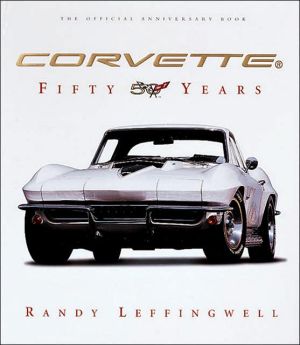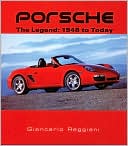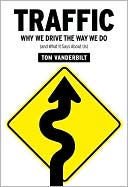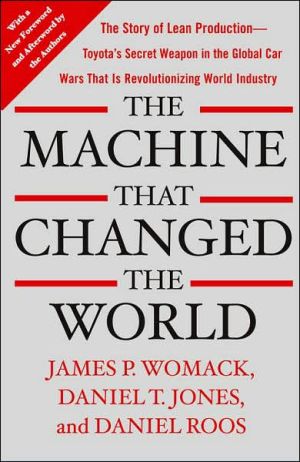Corvette: Fifty Years: The Official Anniversary Book
Officially licensed by General Motors, Corvette: Fifty Years is a colorful, nostalgic and commemorative look at the obstacles and achievements of this classic American sports car, which celebrates its 50th anniversary in 2003. The book provides new insight into the fascinating story of the beloved Corvette with unpublished stories and previously unseen historical and all-new color photographs. Witness Corvette's 1953 Motorama debut, the fervor generated by the Blue Flame Special, and the...
Search in google:
Covering 50 full years of Corvette history, this book features stunning colorphotographs from master lensman Randy Leffingwell. Library Journal For 50 years, the iconic Corvette has reigned as America's only sports car. In fact, it is one of the few nameplates from the 1950s that is still around today. To celebrate the Corvette's anniversary, the publisher enlisted auto historian Leffingwell, who does justice to the subject with a book officially licensed by General Motors. Proceeding in intervals by decade, the book moves through the history of the Corvette from its humble beginnings in 1953, when it sold only 300 copies, to the present day, when it sells tens of thousands and beyond. Although the history is notable, it is the photography that sets this book apart. Of the highest quality in size and reproduction, Leffingwell's more than 400 color images show the various production models, but many custom and one-off body styles are represented as well. Highly recommended.-Eric C. Shoaf, Brown Univ. Lib., Providence, RI Copyright 2003 Cahners Business Information.
CORVETTE Fifty Years\ \ By Randy Leffingwell \ MBI Publishing Company\ Copyright © 2002 Randy Leffingwell\ All right reserved.\ ISBN: 0760311803\ \ \ \ A NEAR INEVITABILITY\ The Corvette could only have come from General Motors. This is not just because Chevrolet general manager Tom Keating, chief engineer Ed Cole, and vice president of styling Harley Earl agreed this new car would be badged as a Chevrolet. It was more involved than that. The Corvette resulted from 30 years of work by GM'S greatest thinker, Alfred Pritchard Sloan. Sloan and Donaldson Brown together devised a far-sighted management strategy in the early 1920s. Brown became Sloan's co-conspirator in the years after GM's board elected Sloan president in May 1923. By then, these two men had undone the conglomerate mess that their former boss, the entrepreneurial automobile enthusiast William Crapo Durant, had left behind.\ Durant was the father of General Motors. He envisioned a system in which GM owned and controlled every part and product needed to manufacture his automobiles. The term for this, vertical integration, was not coined yet. What Durant created was a less laudable free will among the companies he owned. By the time he walked out in December 1920, his system had devolved into a corporate free-for-all. Durant had too many automakers producing too many similar models at too near the same price with no central control.\ The healthy post-World War I U.S. economycollapsed in 1920 as Europe's recovery hit full speed. The recession hit hard in the United States. The fundamental, difference between Billy Durant's car company and Henry Ford's operations took giant General Motors down to second place. In the best of times, Durant's products competed with one another. As money tightened, he had no small, basic, cheap car to sell, as Ford did. Durant soon had no corporate income.\ Sloan joined GM in 1916. Brown arrived at GM when Pierre S. du Pont stepped in to become GM president as part of the du Pont's efforts to bail GM out of its enormous troubles in 1921. With du Pont in place as the hard decision maker, Brown became GM's financial brain and Sloan became its backbone. Together, they made something rational out of the chaos.\ Brown, Sloan, and du Pont monitored each company's performance individually, examining and revising GM's entire product lineup. By late 1921, they offered cars ranging from $700 Chevrolets to $6,000 Cadillacs.\ Brown established the goal of achieving the highest possible return on rate of investment, a theory that guides most successful companies today. Sloan and Brown believed the purpose of any company was to protect and enrich the investment of its owners, stockholders-in GM's case-a philosophy that would affect product decisions to this day. He and Brown accepted delayed corporate gratification, as Sloan wrote years later in his autobiography, My Years with General Motors. "The question is not simply one of maximizing the rate of return for a specific short period of time. Mr. Brown's thought on this was that the fundamental consideration was [to achieve] an average return over a long period of time." If ever any single product in automotive history demanded patience to achieve its return on investment, it was Chevrolet's sports car. That was only one of several elements needed for the Corvette to succeed, however.\ As Arthur Kuhn wrote in his book, GM Passes Ford 1918-1938, Brown and Sloan recognized that offering an automobile "exclusive in design, possessing superior engineering qualities and carrying with it a peculiar appeal to fashion afforded the opportunity for a favorable rate of return." This, as Brown wrote in his own book, Some Reminiscences of an Industrialist, required "ingenuity in anticipating the changing tastes of the buying public." They levered that philosophy into place and pressed forward in other ways that enabled the corporation to serve its stockholders best.\ A CAR FOR EVERY PURSE\ It was Sloan who, as early as 1921, had verbalized the evolving General Motors philosophy as a slogan: "A car for every purse and purpose." By 1925, Sloan and du Pont recognized a growing market in Europe for their cars, but they concluded it was wiser to buy an existing company and its products and factories than to start from scratch. GM acquired major interests in Vauxhall Automobiles in the United Kingdom and Adam Opel A. G. in Germany. At home, new customers were created when GM began financing purchases of its cars. It not only brought in first-time buyers, it benefited shareholders who realized there were new profits in interest payments. By late 1925, General Motors produced one of every five automobiles sold in the United States and kept one dollar in every three dollars of profit the auto industry reaped.\ Sloan demanded his divisions communicate with each other on everything from engineering to advertising. He and other vice presidents began touring the United States and Europe to see firsthand new mechanical and engineering developments and styling trends. "I tried to keep my eyes open for any new things that applied to the automobile industry," he recalled years later. He and Donaldson Brown created a Policy Group for Social and Economic Trends that monitored the effects of these conditions on present and future plans.\ Alfred Sloan was among the first of America's corporate pillars to recognize that product appearance influenced sales. Sloan described the revelation in his autobiography. The Auburn Automobile Company introduced 1924 models with fully enclosed bodies (in contrast to Ford's still open Model Ts). The new Auburns, mechanically identical to the previous year, featured "advanced styling and coloring. A sweeping belt line ... often painted in contrasting colors [that] gave a striking impression." Sloan and Brown took note when Auburn's revenue losses from 1923 turned to gains before 1925.\ Lawrence P. Fisher, general manager of Cadillac division and one of the founding brothers of Fisher Body (the corporation's body maker but still outside GM at this point), agreed with Sloan that GM would benefit by paying more attention to the cars' appearance. Cadillac still sold bare chassis to wealthy clients who wanted to be seen in personalized custom vehicles. One of Cadillac's Los Angeles dealers, Don Lee, had acquired J.W. Earl Automobile Works, a custom coach-building firm, eight years earlier. Many of Lee's customers were Hollywood stars, flashy, trend-setting people who wanted cars that reflected their screen images and, more important, were different from anyone else's.\ J.W. Earl had started in 1911 making custom car and truck bodies as service vehicles and props for the emerging talking-film industry. By 1918, when it showed its first complete automobiles at the L.A. Auto Show, Earl occupied its own three-story, block-long building south of downtown Los Angeles. Earl's Stanford University educated son, Harley, had designed not only car bodies but also airplane fuselages for the Glen L. Martin Company, one of southern California's earliest aircraft manufacturers. Airplane lines and contours were part of Harley Earl's post-Stanford education.\ Fisher first visited Harley Earl in early 1925. He watched the 32-year-old designer forming scale models of cars in clay. This technique let Earl experiment with lines, shapes, and reflections of light before committing to large-scale wood mock-ups. Earl blended fender lines into running boards, hoods into windshields, engine compartment sheet metal into body side panels. For Fisher this was a revelation. At most American car makers, the chassis engineering division designed and delivered its frame complete with the engine, hood, radiator, running gear, suspension, wheels, tires, and fenders to each body division, which bolted on its own passenger compartment, each element conceived independently. Fisher saw Earl with shapes that appeared molded from one piece and cast from one mind.\ Fisher brought Sloan photographs. They had a new entry-level Cadillac for spring 1927 called the LaSalle, part of Sloan's effort to fill holes in GM's price range. They hired Earl as a consultant to design a car as beautiful as his customs. While he was in Detroit, Fisher showed him working drawings of the 1927 Cadillacs. Fisher and Sloan now feared these would be overshadowed by Earl's LaSalle. Harley pronounced the Cadillacs drab but thought that fitting wire wheels would at least lower them, making them appear longer and more dramatic. He suggested using bright paint. Cadillac in 1924 had offered three colors for its model range. "Hollywood Harley" recommended they offer cars in any of 500 color and interior options.\ The LaSalle turned heads and brought the buyers into showrooms. Sales of the Cadillacs brought Earl back to General Motors to head Sloan's newest creation, the Art and Colour Section, starting on July 27, 1927. Answering only to Sloan, he was to direct the design of general production cars and do research and development work by creating additional special car designs.\ Not until September 1940 did his promotion to vice president of a renamed styling section give him the title to match his impact. This came partially as the result of a highly visible failure in 1929. Earl designed a car for Buick, GM's most profitable division since 1918. He intended for the car body to fit down inside the chassis, but the engineering department "redesigned" it so it would mount onto its existing chassis without any additional work. Preoccupied by design assignments that followed the Buick, Earl never saw the car after its designs left his studio in late 1927.\ The design would have been a gorgeous and bold leap from the previous model. With engineering's revisions, it was a disaster, quickly dubbed the "pregnant Buick." Division sales plummeted and Sloan pulled it from production after only one year. The damage was brutal; the Depression, which began in October 1929, hit Buick the hardest of any GM division, turning the once profitable nameplate into a money-losing division.\ Earl escaped unscathed. Sloan reacted decisively. He tightened his authority over manufacturing and production engineers. The Buick clarified for everyone the impact of successful and awful design. It fathered another GM innovation: the annual model change. Previously, successful car builders updated their models whenever improvements were ready, generally shutting down production to instigate the changes. Sloan first observed this new effect in 1924 among weaker competitors Hudson, Dodge, and Chrysler, who, in that year's shrinking market, brought out new models with heavy promotion and experienced a healthy and enduring surge in sales. Sloan's sales department began to capitalize on this phenomenon. "Each year," he wrote in his autobiography, "we build the best car we possibly can to satisfy our customer, and then the next year we build another to make him dissatisfied." There was sound Sloan-Brown business sense to this. "The primary object of the corporation," he wrote, "was to make money, not just to make motor cars."\ When Earl's 1933 Chevrolets were introduced, the public, startled by the bulging curves and uneasy proportions of the 1929 Buick, loved them. People called the cars stylish, judging the overall design unified. The success of these cars led the public to label their creators "stylists."\ Some within GM called Earl's department "the beauty parlor," but their opinions changed as year-end reports tallied each division's performance. Sloan was an advocate from the start, and Earl's influence grew.\ "For a long while," Sloan wrote, "the Art and Colour Section occupied quarters in the General Motors Building Annex in Detroit. The focal point of the work area was the blackboard room. To this room came executives from Fisher Body and every car division. We were all window-shoppers in the Art and Colour 'sales' rooms," he continued. "Art and Colour was proposing new designs, presenting new idea sketches, selling progress. As time went by more and more of these ideas appeared to be feasible."\ Earl first visited Europe for GM in 1927 with Lawrence Fisher, calling on every car manufacturer and car body maker they could get in to see. They learned that what worked in one part of the world would not be appropriate in another. Some ideas would succeed only if they were adapted and modified to match GM's assessment of what was good for America and good for GM customers.\ WorldWar II ended in Europe in May 1945 and in Japan in August. Years of hard work and good wages with few goods available for consumers had left Americans with pent-up desires, especially for products using steel or rubber, two materials critical to war efforts. When North Korea invaded South Korea on June 25, 1950, it seemed worrying but distant. Americans went to fight because it became clear that communism was the real enemy, but it was another war thousands of miles away. It need not interrupt the return to American life that many had begun anxiously.\ In 1950, there were 1.5 million television sets in America. A year later there would be 15 million sets. In November 1952, Americans elected General Dwight David "Ike" Eisenhower their next president. Eisenhower represented the battle against the Red Menace, the political code name for the threat of communism taking over the world. He quickly authorized an interstate highway system, similar to the auto routes, autobahns, and autostradi of Europe. The long, smooth American roads, meant for efficient movement of U.S. armed forces, fueled a hunger for automobiles. The country was developing a middle class that had enough money to pay its bills with some left over. Leisure time became a concept and then a reality, and the automobile helped. By December 1, 1950, the United States had 2,200 drive-in theaters, double the year before. Magazines and newspapers questioned whether or not automobiles would kill movie theaters.\ By the early 1950s, air conditioning, radios, and automatic transmissions were primary options that General Motors intended to fit as standard equipment on all but its lowest priced products. GM felt\ (Continues...)\ \ \ \ \ Excerpted from CORVETTE Fifty Years by Randy Leffingwell Copyright © 2002 by Randy Leffingwell\ Excerpted by permission. All rights reserved. No part of this excerpt may be reproduced or reprinted without permission in writing from the publisher.\ \
\ From Barnes & NobleDazzling color photographs of nearly 100 Corvettes brighten this official book to mark the 50th year of America's original sports car. Historical photographs and Randy Leffingwell's carefully researched text make this large-format pictorial as authoritative as it is attractive. The pictures of development prototypes are an added treat.\ \ \ \ \ Library JournalFor 50 years, the iconic Corvette has reigned as America's only sports car. In fact, it is one of the few nameplates from the 1950s that is still around today. To celebrate the Corvette's anniversary, the publisher enlisted auto historian Leffingwell, who does justice to the subject with a book officially licensed by General Motors. Proceeding in intervals by decade, the book moves through the history of the Corvette from its humble beginnings in 1953, when it sold only 300 copies, to the present day, when it sells tens of thousands and beyond. Although the history is notable, it is the photography that sets this book apart. Of the highest quality in size and reproduction, Leffingwell's more than 400 color images show the various production models, but many custom and one-off body styles are represented as well. Highly recommended.-Eric C. Shoaf, Brown Univ. Lib., Providence, RI Copyright 2003 Cahners Business Information.\ \








